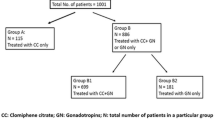Abstract
Purpose
To compare the efficacy of clomiphene citrate (CC) and recombinant FSH (rFSH) protocols in ovarian stimulation (OS)/intrauterine insemination (IUI) cycles for couples with unexplained infertility or male subfertility.
Methods
One hundred and eighty-nine patients with unexplained or male subfertility were randomized to treatment with 100 mg/day CC for 5 days (93 patients) or rFSH with starting dose of 75–100 IU daily (96 patients). The main outcome measurement was ongoing pregnancy rate (OPR).
Results
The number of preovulatory (≥17 mm) follicles on the day of hCG administration was significantly greater in the rFSH group than in the CC group (1.7 vs. 1.4, P = .01). Multifollicular growth was observed in 35.1% in the CC group and 54.8% in the FSH group (P = .01). The OPR per cycle was 9.6 and 15.6% for CC and rFSH groups, respectively (P = .31).
Conclusions
Recombinant FSH is superior to CC for enabling multifollicular development in OS/IUI cycles of unexplained and male subfertile couples. Although this finding did not lead to a statistically significant superiority of rFSH in terms of clinical outcomes, the presence of relative increase by 62.5% in OPR with rFSH may be regarded as a clinically significant trend.

Similar content being viewed by others
References
Duran HE, Morshedi M, Kruger T, Oehninger S (2002) Intrauterine insemination: a systematic review on determinants of success. Hum Reprod Update 8:373–384
Verhulst SM, Cohlen BJ, Hughes E, Te Velde E, Heineman MJ (2006) Intra-uterine insemination for unexplained infertility. Cochrane Database Syst Rev 18:CD001838
Bensdorp A, Cohlen BJ, HeinemanMJ, Vanderkerchove P (2007) Intra-uterine insemination for male subfertility. Cochrane Database Syst Rev 4:CD000360
Vitthala S, Gelbaya TA, Hunter H, Roberts SA, Nardo LG (2008) Stimulated intrauterine insemination (SIUI) and donor insemination (DI) as first line management for a selected subfertile population: the Manchester experience. J Assist Reprod Genet 25:431–436
Bensdorp AJ, Slappendel E, Koks C et al (2009) The INeS study: prevention of multiple pregnancies: a randomised controlled trial comparing IUI COH versus IVF e SET versus MNC IVF in couples with unexplained or mild male subfertility. BMC Womens Health 9:35
Farhi J, Orvieto R (2010) Cumulative clinical pregnancy rates after COH and IUI in subfertile couples. Gynecol Endocrinol 26:500–504
Karlstrom PO, Bergh T, Lundkvist O (1993) A prospective randomized trial of artificial insemination versus intercourse in cycles stimulated with human menopausal gonadotropin or clomiphene citrate. Fertil Steril 59:554–559
Hannoun A, Abu-Musa A, Kaspar H, Khalil A (1998) Intrauterine insemination IUI: the effect of ovarian stimulation and infertility diagnosis on pregnancy outcome. Clin Exp Obstet Gynecol 25:144–146
Ecochard R, Mathieu C, Royere D, Blache G, Rabilloud M, Czyba JC (2000) A randomized prospective study comparing pregnancy rates after clomiphene citrate and human menopausal gonadotropin before intrauterine insemination. Fertil Steril 73:90–93
Balasch J, Ballesca JL, Pimentel C, Creus M, Fabregues F, Vanrell JA (1994) Late low-dose pure follicle stimulating hormone for ovarian stimulation in intra-uterine insemination cycles. Hum Reprod 9:1863–1866
Matorras R, Diaz T, Corcostegui B, Ramon O, Pijoan JI, Rodriguez-Escudero FJ (2002) Ovarian stimulation in intrauterine insemination with donor sperm: a randomized study comparing clomiphene citrate in fixed protocol versus highly purified urinary FSH. Hum Reprod 17:2107–2111
Dankert T, Kremer JA, Cohlen BJ et al (2007) A randomized clinical trial of clomiphene citrate versus low dose recombinant FSH for ovarian hyperstimulation in intrauterine insemination cycles for unexplained and male subfertility. Hum Reprod 22:792–797
World Health Organization (1999) Laboratory manual for the examination of human semen and semen-cervical mucus interaction, 4th edn. Cambridge University Press, Cambridge
Kruger TF, Acosta AA, Simmons KF, Swanson RJ, Matta JF, Oehninger S (1998) Predictive value of abnormal sperm morphology in in vitro fertilization. Fertil Steril 49:112–117
Nakajima AK, Smith LL, Wong B et al (1999) A randomized trial of CC plus IUI versus rFSH plus IUI for the treatment of subfertility. Fertil Steril (Suppl) 72:208
Merviel P, Heraud MH, Grenier N, Lourdel E, Sanguinet P, Copin H (2010) Predictive factors for pregnancy after intrauterine insemination (IUI): an analysis of 1038 cycles and a review of literature. Fertil Steril 93:79–88
Athaullah N, Proctor M, Johnson NP (2002) Oral versus injectable ovulation induction agents for unexplained subfertility. Cochrane Database Syst Rev 3:CD003052
Cantineau AEP, Cohlen BJ (2007) Ovarian stimulation protocols (anti-oestrogens, gonadotrophins with and without GnRH agonists/antagonists) for intrauterine insemination (IUI) in women with subfertility. Cochrane Database Syst Rev 2:CD005356
Howles CM (1996) Genetic engineering of human FSH (Gonal-F). Hum Reprod Update 2:172–191
Out HJ, Mannaerts BM, Driessen SG, Coelingh Benningk HJ (1996) Recombinant follicle stimulating hormone (rFSH; Puregon) in assisted reproduction: more oocytes, more pregnancies: results from five comparative studies. Hum Reprod Update 2:162–171
Demirol A, Gurgan T (2007) Comparison of different gonadotrophin preparations in intrauterine insemination cycles for the treatment of unexplained infertility: a prospective, randomized study. Hum Reprod 22:97–100
Acknowledgments
The authors thank İçten Kıvançlı, M.D., for helping collection of data and Barış Ata, M.D., for his suggestions and critical reading of the manuscript.
Conflict of interest
We declare that we have no conflict of interest.
Author information
Authors and Affiliations
Corresponding author
Rights and permissions
About this article
Cite this article
Berker, B., Kahraman, K., Taskin, S. et al. Recombinant FSH versus clomiphene citrate for ovarian stimulation in couples with unexplained infertility and male subfertility undergoing intrauterine insemination: a randomized trial. Arch Gynecol Obstet 284, 1561–1566 (2011). https://doi.org/10.1007/s00404-011-1997-4
Received:
Accepted:
Published:
Issue Date:
DOI: https://doi.org/10.1007/s00404-011-1997-4



